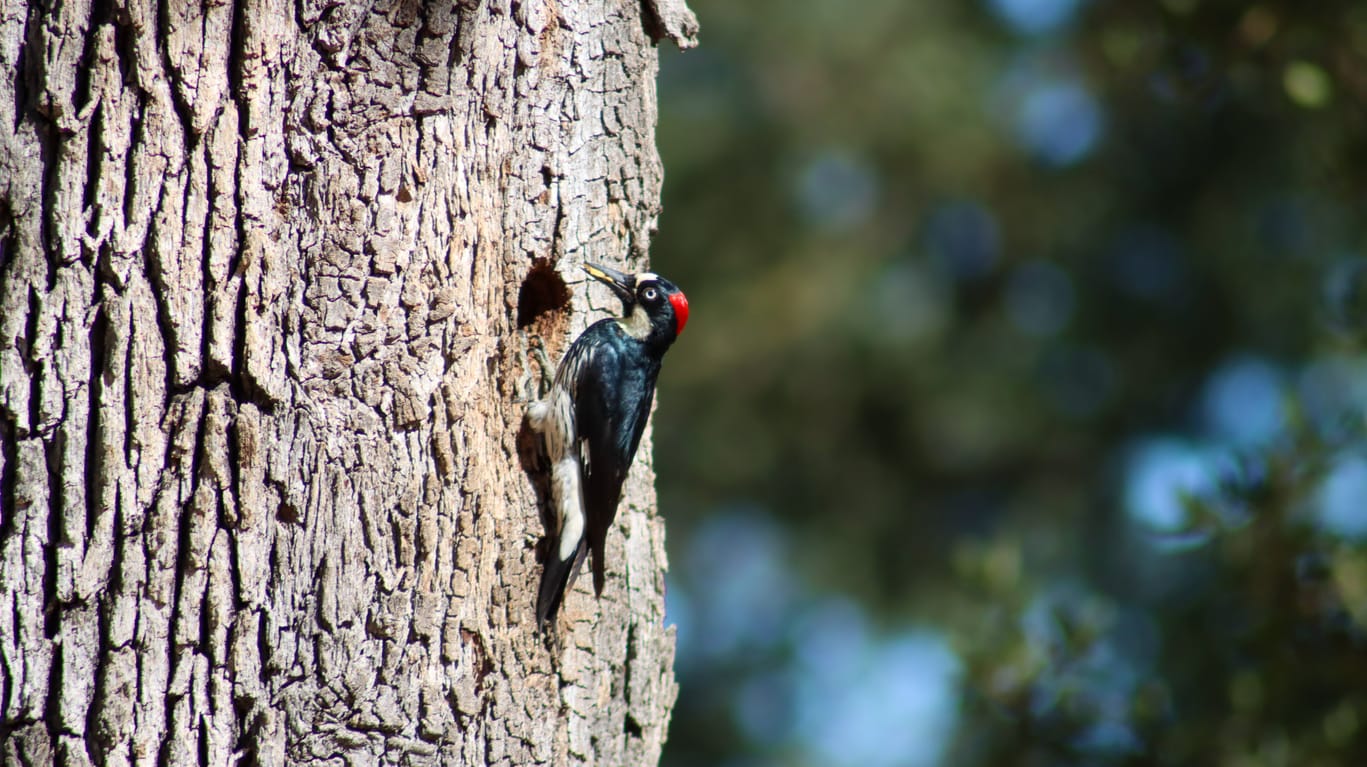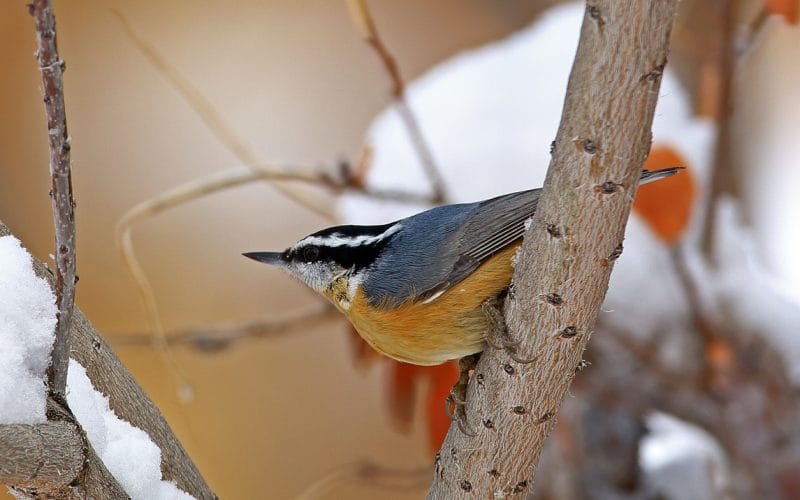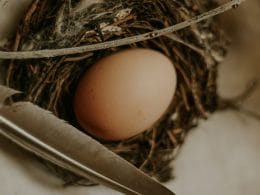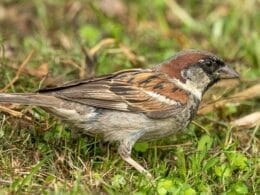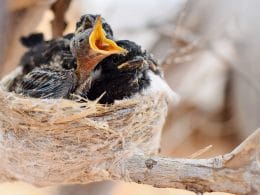The woodpecker is one of the most mesmerizing bird species in nature. As the name suggests, woodpeckers enjoy pecking at wood, as well as other surfaces, on occasion.
Despite what some might believe, though, these birds don’t eat the wood they peck. This begs the question: why do woodpeckers peck wood, exactly? Let’s find out.
Short Answer
Woodpeckers peck at wood for three main reasons:
- In search of food
- In search of a place to build a nest
- To attract mates and establish territory
Overview of Woodpeckers

There are 200 different woodpecker species around the world. In nature, the lifespan of these birds varies from 4 to 12 years.
Forests and woodland environments are home to the majority of woodpeckers. Further, most woodpeckers spend the entire year in the same region. It’s difficult to evict a woodpecker from its territory, in fact!
Woodpeckers can make a wide range of alarm sounds, but they’re mostly known for drumming, which we’ll be discussing shortly.
Although many people believe that woodpeckers eat wood, this isn’t the case. The birdies use their beaks to drill holes in wood. It allows them to build nesting holes cavities and it enables them to catch bugs and larvae.
Author Note: Woodpeckers have a pecking pace of roughly 20 pecks per second. They peck somewhere between 8,000 and 12,000 times every day!
When it’s broad daylight, they’re super active. But when there isn’t any sunlight, they’ll most likely be sleeping.
What Does the Pecking Mean?
Woodpeckers use pecking as a means of communication.
There are different reasons why woodpeckers peck. Oftentimes, they’re looking for something to eat. Other times, they’re trying to build a nest or find a partner.
If you observe closely, the way these birds peck reveals why they’re behaving the way they are.
In Search of Food
Woodpeckers don’t make holes in healthy trees. They’ll gnaw at wood that is infested by bugs. If a tree has a bug infestation, it’s in bad health and on the verge of dying, after all.
Woodpeckers hunt for larvae in the summer. Many bugs hibernate for the winter in cracks in the fall and spring but wander around on cold nights.
When woodpeckers detect insect movements, they make small holes in the tree. They then grab the insects they want with their long tongues. The holes are horizontal and in a straight line.
Different species of woodpeckers consume other nutrients found inside trees, such as tree sap. Some birds will feed on fruit or seeds.
Some woodpecker species dig deep holes in the trees to store food. They guard these areas and hide the openings by covering them with wood.
Nesting and Mating
Woodpeckers use pecking to create their nests. The birds will make nests inside the trees, where the cover protects the birds from the environment. The birds also peck to notify others that the area is their territory.
Another reason why woodpeckers peck is to find a mate after they’ve made a nest. You’ll hear this kind of pecking most often during the mating season in spring.
Woodpeckers build their nests in holes that they create themselves. When they dig a single large, big hole, it may be a sign that they’re working to build a nest. The birds generally lay 6-8 eggs at a time.
Top Tip: There’s a distinct way to identify if it’s a nest or just a regular hole. Nesting holes are very large and more visible compared to regular holes.
What’s more, nesting chambers are often spherical or rectangular. They’re only slightly larger than the size of the bird.
Note that woodpeckers are picky about where they drill their cavities. They prefer trees with a tough external shell and a softer interior.
It’s also worth noting that some species reuse their nest holes year after year, while others prefer to build fresh ones.
Which Trees Do Woodpeckers Like?
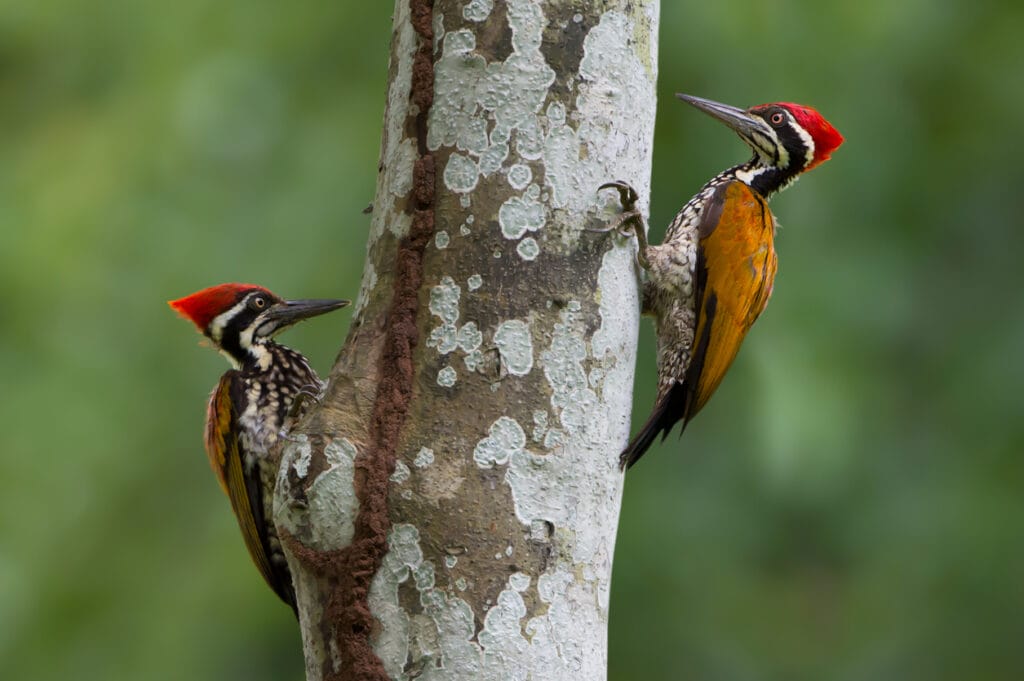
Pine trees attract woodpeckers because of their sweet sap and pine nuts. They also enjoy acorns from oak trees. Cedar and redwood are also appealing to them.
Snags, dead trees, and stumps are all good places for them to build their nests. They empty the rotten wood and nest inside.
What Is Drumming?
Drumming trees is a behavior that both woodpecker sexes do. Drumming is when they peck in a rhythm. This action serves as a means of communication since woodpeckers lack vocal cords.
They usually select a dry, brittle tree and pound on it with repeated bursts of drumming. Drumming on metal or wood structures is most common in the spring. This happens to attract mates during the mating season in March or April.
The drumming might happen several times in a single day and can persist for days or months.
Woodpeckers would pound against a metal object. It’s to make a statement that this is their territory. The pecking of the metal object makes the loudest noise possible to scare others.
Although woodpecker drumming doesn’t cause much harm, the noises can be annoying.
Different species have different drumming rhythms. Sapsuckers play a rhythmic drum that pauses and plays at a different tempo. They usually do it in an unusual sequence. A quick drum-roll sound is used by Hairy Woodpeckers.
Author Note: Downy Woodpeckers do sluggish drumming. They play for several moments, then stop for a few moments before repeating.
Do Woodpeckers Cause Damage?

In most cases, woodpeckers produce only minor damage. However, if they get access to your home, they may do unwelcome harm. While they won’t cause substantial damages, they may harm vital items, like the power wiring.
Trees
As mentioned before, woodpeckers don’t usually peck on fully healthy trees. The wood within the tree is either dead or infested with insects. The internal damage is insufficient to cause damage to the tree’s external surface.
Woodpeckers are utilized by certain park rangers as an alert system for unhealthy trees. The park rangers remove diseased trees before they collapse with the aid of woodpecker behavior.
Houses
Woodpeckers don’t distinguish between trees and other types of wood. As a result, they might cause damage to your home.
The holes create an increased risk of insect infestation as they provide an entry point to your home. Rainwater could enter the house through these holes, causing mold development.
Other concerns could develop as well. However, these incidents occur in rare cases and the damages are usually minimal.
They can also cause damage to other non-wood materials such as metal. Water pipes, plumbing systems, and electrical cables can be damaged by a determined woodpecker.
Top Tip: A sequence of little and deep holes is the norm of woodpecker drills. These holes have a horizontal or vertical pattern. Bigger nesting cavities, on the other hand, may exist.
The noise and the consistency of the openings will state that the harm is caused by the drilling birds.
How Can Woodpeckers Withstand the Pecking?
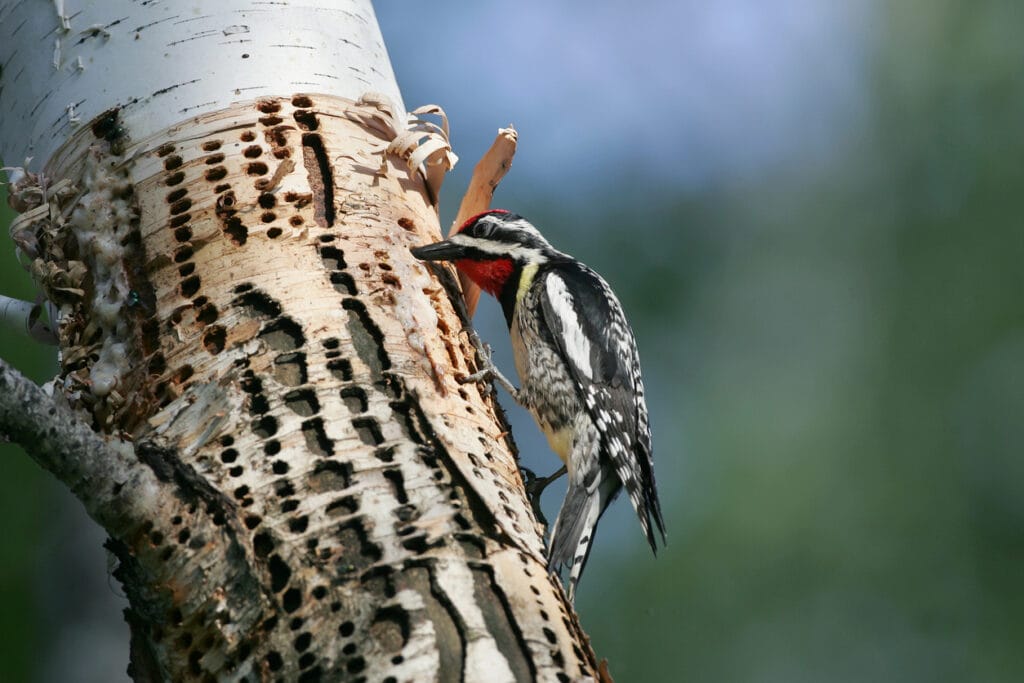
You might be wondering how a woodpecker can peck for so long without becoming wounded or even exhausted. This is due to the bird’s anatomy, which allows it to resist the violent pecking it undergoes on a daily basis.
Each part of the bird’s body serves a purpose in ensuring the bird’s safety.
Feet
Woodpeckers have two forward toes and two backward toes. Their toes’ anatomy makes it easy for them to hold the side of a tree.
These are known as zygodactyl feet, in which the feet can look like an X. It helps them to balance as they peck.
Beak
The beak of a woodpecker has two layers. The exterior is hard and rigid, similar to a shell, while the interior is soft.
A spongy bone sits behind the beak, absorbing most of the force of the pecking. As a result, they may peck 10,000 times a day without injuring themselves.
Head
There’s fluid between the woodpecker’s skull and brain. There’s also a muscle-wrapped bone that transmits vibrations to the back of the skull and the tongue. The skull contains air pockets that protect the brain from trauma.
Tongue
Their tongue is made up of nine thin bones. It enables them to reach deep further into the tree with their tongue.
Woodpeckers have tongues that are about twice the length of their beaks. It helps them to reach the pests inside the cavities they dig out. Their tongues are around 4 inches long.
The lengthy tongue coils around the skull and the skin when the tongue is resting.
Their tongues are sticky. Most woodpeckers have thorny tongues or sticky secretions on their tongues. These features assist them to take out bugs from their place.
Hearing
Woodpeckers have exceptional hearing and can easily detect bugs in the bark. They use sounds to find their target and determine where to begin pecking to get to their food.
Nose
The noses of woodpeckers are hairy. Feathers protect their nostrils to prevent wood pieces and dust out while they dig.
Why Are Woodpeckers Important to the Environment?
Woodpeckers are a crucial part of the ecosystem as they help control insect populations. They also build nest holes for other birds and mammals who are unable to do it themselves.
The birds contribute to the detection of tree problems as well. If a tree has irregular cavities across the trunk and branches, it could mean there’s a problem within the tree. It’s likely that the tree has bugs or is dying.
Author Note: Woodpeckers may also rip the wood off trees and spread it on the ground. This is also an indicator that the tree isn’t healthy.
How to Keep Woodpeckers Away?

Not only do woodpeckers peck on trees, sometimes they peck on the wood structure of your house. There are many ways in which you can repel the birds away.
The availability of bugs within the house is one of the reasons woodpeckers will peck on your house. So, check to see whether you have a pest infestation. It could be both alive and dead insects. If this is the case, hire an exterminator or use bug sprays to get rid of the pests.
You can place a bird feeder far away from your premises so that they don’t target your home. You can also use reflective materials such as reflective tapes or mylar balloons.
If you don’t want woodpeckers pecking at your trees, wrap them with materials that make it tough for them to get through, like foam.
Water sprinklers can splatter the area surrounding your home. The birds will be alarmed by both the noise and water. However, it may not be as effective as other methods.
You can place wind chimes in the area where you don’t want birds to come. Woodpeckers may be scared away by the sound they produce.
Summary
Woodpeckers peck wood in search of food or a place to build a nest. They also do it to attract mates and mark their territory. They use a technique called drumming. This technique involves pecking in a rhythm.
Woodpeckers prefer softwood trees. That said, they find cedar and redwood very appealing. They can peck at hardwood trees as well as materials other than wood, on occasion.
Woodpeckers, despite being a nuisance because of their pecking, help manage infestations and they provide tree cavities for birds and mammals that aren’t as adept at digging as they are.
To keep woodpeckers away from your home, you can use reflective materials or wind chimes. You can also place a bird feeder somewhere far from your home so that they don’t come pecking at your trees.
FAQ
They have excellent hearing which narrows down the location of prey. They then peck until they find the exact spot that the bugs are.
Surprisingly, they are everywhere except for Australia and New Zealand and Antarctica. That is probably because Australia and New Zealand developed in isolation over millions of years and woodpeckers did not fly there.
Put it this way – if something banged on your head at the same force, you would have a concussion over 10 times over.




